University Research Project: International Student Study Destination
VerifiedAdded on 2020/05/28
|12
|2680
|198
Report
AI Summary
This research project explores the factors influencing international students' decisions regarding their study destinations, with a particular focus on Australia. The project begins with interview questions designed to understand the motivations and choices of international students. It then delves into a literature review, examining globalization, decision-making models, and the influence of ethnic backgrounds and cultural factors on student choices. The review covers topics such as economic and sociological models, the impact of cultural attractiveness, and communication strategies used by educational institutions. The project also analyzes the Australian education system, its appeal to international students, and the challenges they face, such as job opportunities. The project references several academic sources to support its findings, offering a comprehensive overview of the topic.
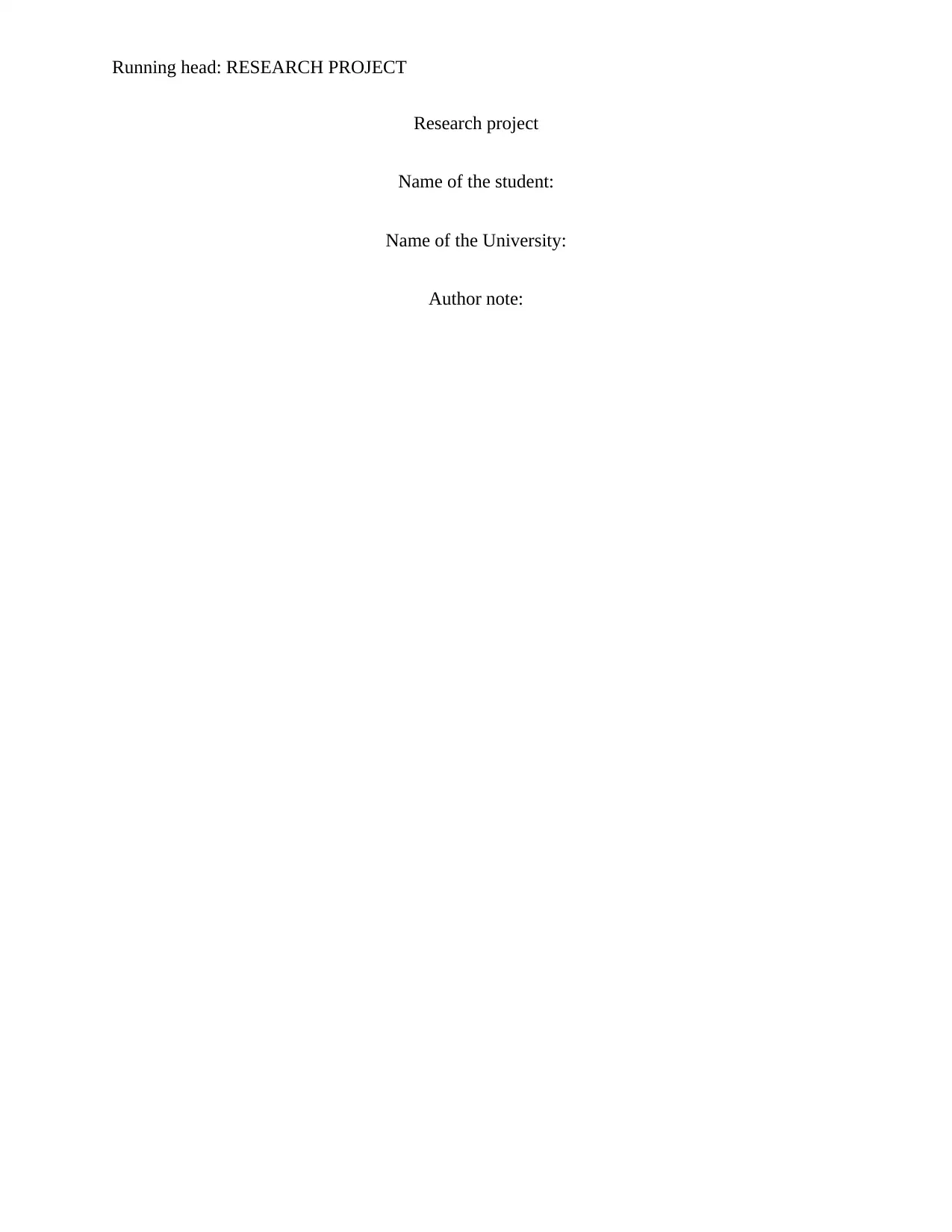
Running head: RESEARCH PROJECT
Research project
Name of the student:
Name of the University:
Author note:
Research project
Name of the student:
Name of the University:
Author note:
Paraphrase This Document
Need a fresh take? Get an instant paraphrase of this document with our AI Paraphraser
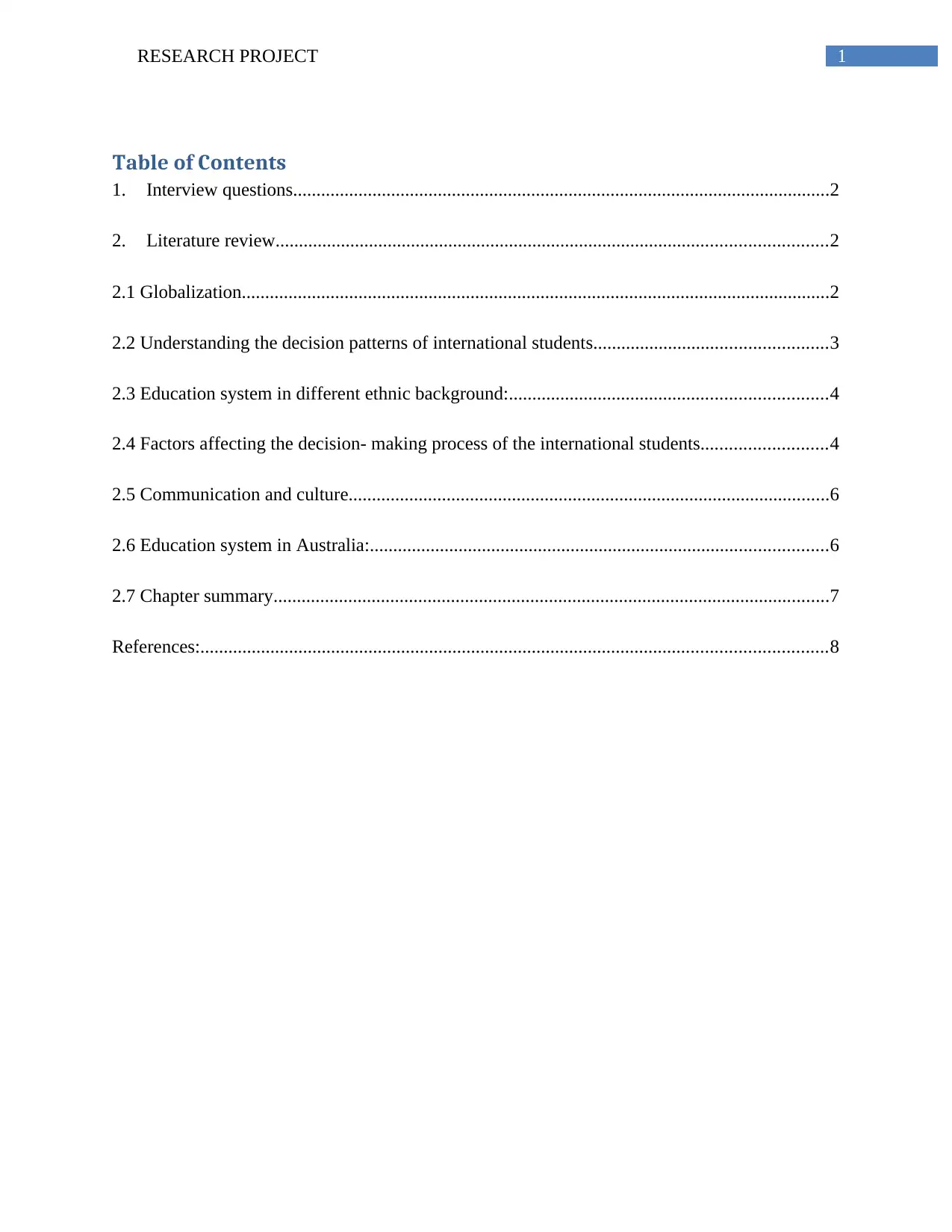
1RESEARCH PROJECT
Table of Contents
1. Interview questions...................................................................................................................2
2. Literature review......................................................................................................................2
2.1 Globalization..............................................................................................................................2
2.2 Understanding the decision patterns of international students..................................................3
2.3 Education system in different ethnic background:....................................................................4
2.4 Factors affecting the decision- making process of the international students...........................4
2.5 Communication and culture.......................................................................................................6
2.6 Education system in Australia:..................................................................................................6
2.7 Chapter summary.......................................................................................................................7
References:......................................................................................................................................8
Table of Contents
1. Interview questions...................................................................................................................2
2. Literature review......................................................................................................................2
2.1 Globalization..............................................................................................................................2
2.2 Understanding the decision patterns of international students..................................................3
2.3 Education system in different ethnic background:....................................................................4
2.4 Factors affecting the decision- making process of the international students...........................4
2.5 Communication and culture.......................................................................................................6
2.6 Education system in Australia:..................................................................................................6
2.7 Chapter summary.......................................................................................................................7
References:......................................................................................................................................8
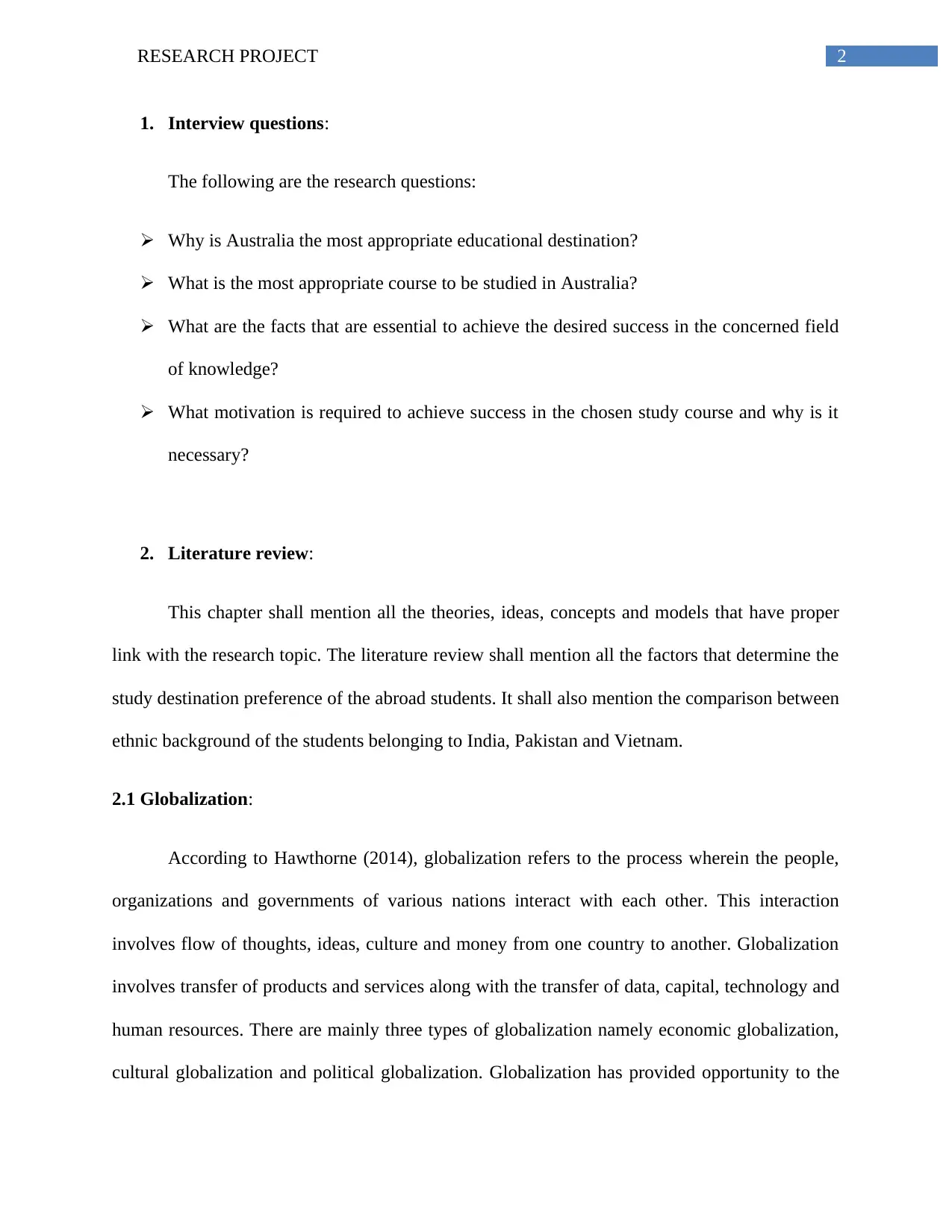
2RESEARCH PROJECT
1. Interview questions:
The following are the research questions:
Why is Australia the most appropriate educational destination?
What is the most appropriate course to be studied in Australia?
What are the facts that are essential to achieve the desired success in the concerned field
of knowledge?
What motivation is required to achieve success in the chosen study course and why is it
necessary?
2. Literature review:
This chapter shall mention all the theories, ideas, concepts and models that have proper
link with the research topic. The literature review shall mention all the factors that determine the
study destination preference of the abroad students. It shall also mention the comparison between
ethnic background of the students belonging to India, Pakistan and Vietnam.
2.1 Globalization:
According to Hawthorne (2014), globalization refers to the process wherein the people,
organizations and governments of various nations interact with each other. This interaction
involves flow of thoughts, ideas, culture and money from one country to another. Globalization
involves transfer of products and services along with the transfer of data, capital, technology and
human resources. There are mainly three types of globalization namely economic globalization,
cultural globalization and political globalization. Globalization has provided opportunity to the
1. Interview questions:
The following are the research questions:
Why is Australia the most appropriate educational destination?
What is the most appropriate course to be studied in Australia?
What are the facts that are essential to achieve the desired success in the concerned field
of knowledge?
What motivation is required to achieve success in the chosen study course and why is it
necessary?
2. Literature review:
This chapter shall mention all the theories, ideas, concepts and models that have proper
link with the research topic. The literature review shall mention all the factors that determine the
study destination preference of the abroad students. It shall also mention the comparison between
ethnic background of the students belonging to India, Pakistan and Vietnam.
2.1 Globalization:
According to Hawthorne (2014), globalization refers to the process wherein the people,
organizations and governments of various nations interact with each other. This interaction
involves flow of thoughts, ideas, culture and money from one country to another. Globalization
involves transfer of products and services along with the transfer of data, capital, technology and
human resources. There are mainly three types of globalization namely economic globalization,
cultural globalization and political globalization. Globalization has provided opportunity to the
⊘ This is a preview!⊘
Do you want full access?
Subscribe today to unlock all pages.

Trusted by 1+ million students worldwide
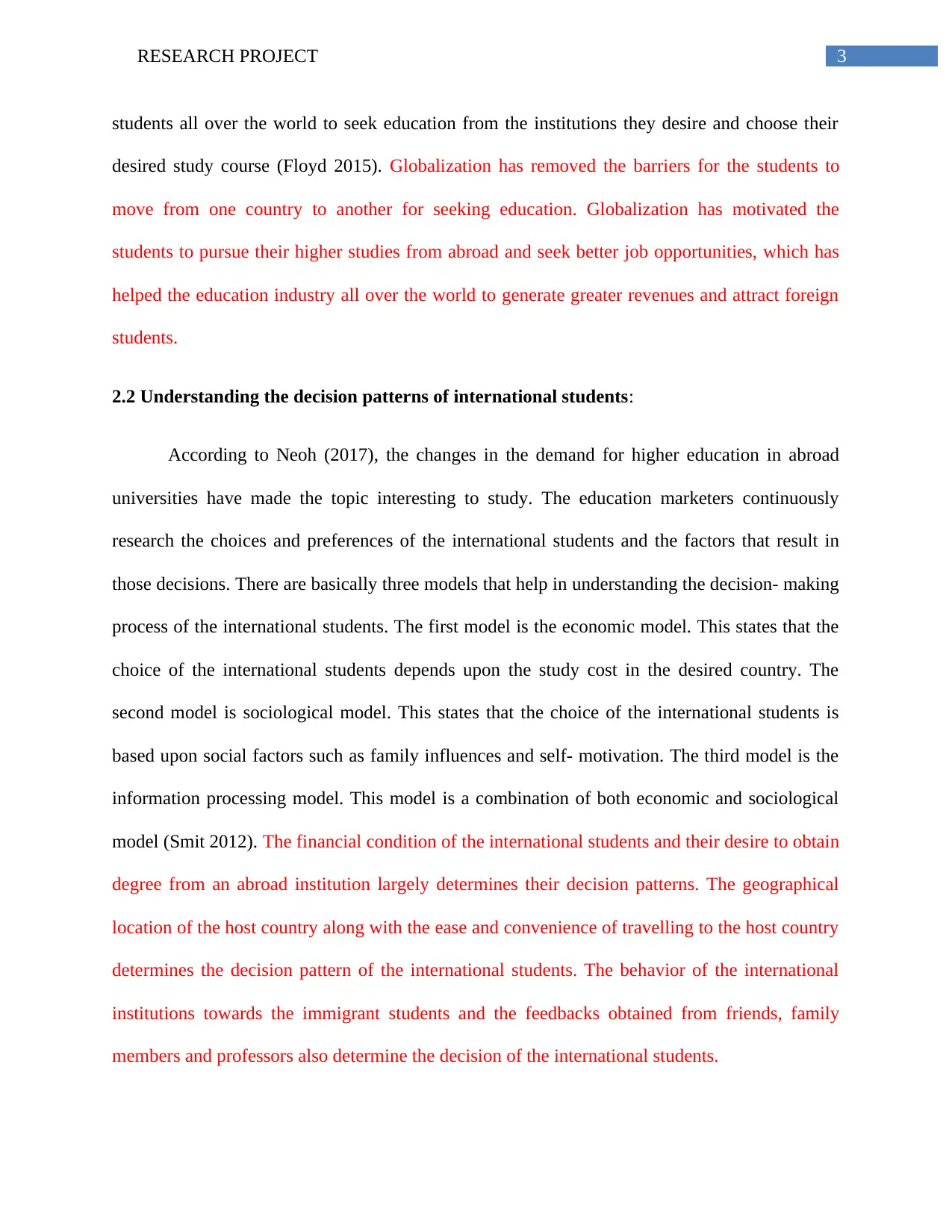
3RESEARCH PROJECT
students all over the world to seek education from the institutions they desire and choose their
desired study course (Floyd 2015). Globalization has removed the barriers for the students to
move from one country to another for seeking education. Globalization has motivated the
students to pursue their higher studies from abroad and seek better job opportunities, which has
helped the education industry all over the world to generate greater revenues and attract foreign
students.
2.2 Understanding the decision patterns of international students:
According to Neoh (2017), the changes in the demand for higher education in abroad
universities have made the topic interesting to study. The education marketers continuously
research the choices and preferences of the international students and the factors that result in
those decisions. There are basically three models that help in understanding the decision- making
process of the international students. The first model is the economic model. This states that the
choice of the international students depends upon the study cost in the desired country. The
second model is sociological model. This states that the choice of the international students is
based upon social factors such as family influences and self- motivation. The third model is the
information processing model. This model is a combination of both economic and sociological
model (Smit 2012). The financial condition of the international students and their desire to obtain
degree from an abroad institution largely determines their decision patterns. The geographical
location of the host country along with the ease and convenience of travelling to the host country
determines the decision pattern of the international students. The behavior of the international
institutions towards the immigrant students and the feedbacks obtained from friends, family
members and professors also determine the decision of the international students.
students all over the world to seek education from the institutions they desire and choose their
desired study course (Floyd 2015). Globalization has removed the barriers for the students to
move from one country to another for seeking education. Globalization has motivated the
students to pursue their higher studies from abroad and seek better job opportunities, which has
helped the education industry all over the world to generate greater revenues and attract foreign
students.
2.2 Understanding the decision patterns of international students:
According to Neoh (2017), the changes in the demand for higher education in abroad
universities have made the topic interesting to study. The education marketers continuously
research the choices and preferences of the international students and the factors that result in
those decisions. There are basically three models that help in understanding the decision- making
process of the international students. The first model is the economic model. This states that the
choice of the international students depends upon the study cost in the desired country. The
second model is sociological model. This states that the choice of the international students is
based upon social factors such as family influences and self- motivation. The third model is the
information processing model. This model is a combination of both economic and sociological
model (Smit 2012). The financial condition of the international students and their desire to obtain
degree from an abroad institution largely determines their decision patterns. The geographical
location of the host country along with the ease and convenience of travelling to the host country
determines the decision pattern of the international students. The behavior of the international
institutions towards the immigrant students and the feedbacks obtained from friends, family
members and professors also determine the decision of the international students.
Paraphrase This Document
Need a fresh take? Get an instant paraphrase of this document with our AI Paraphraser
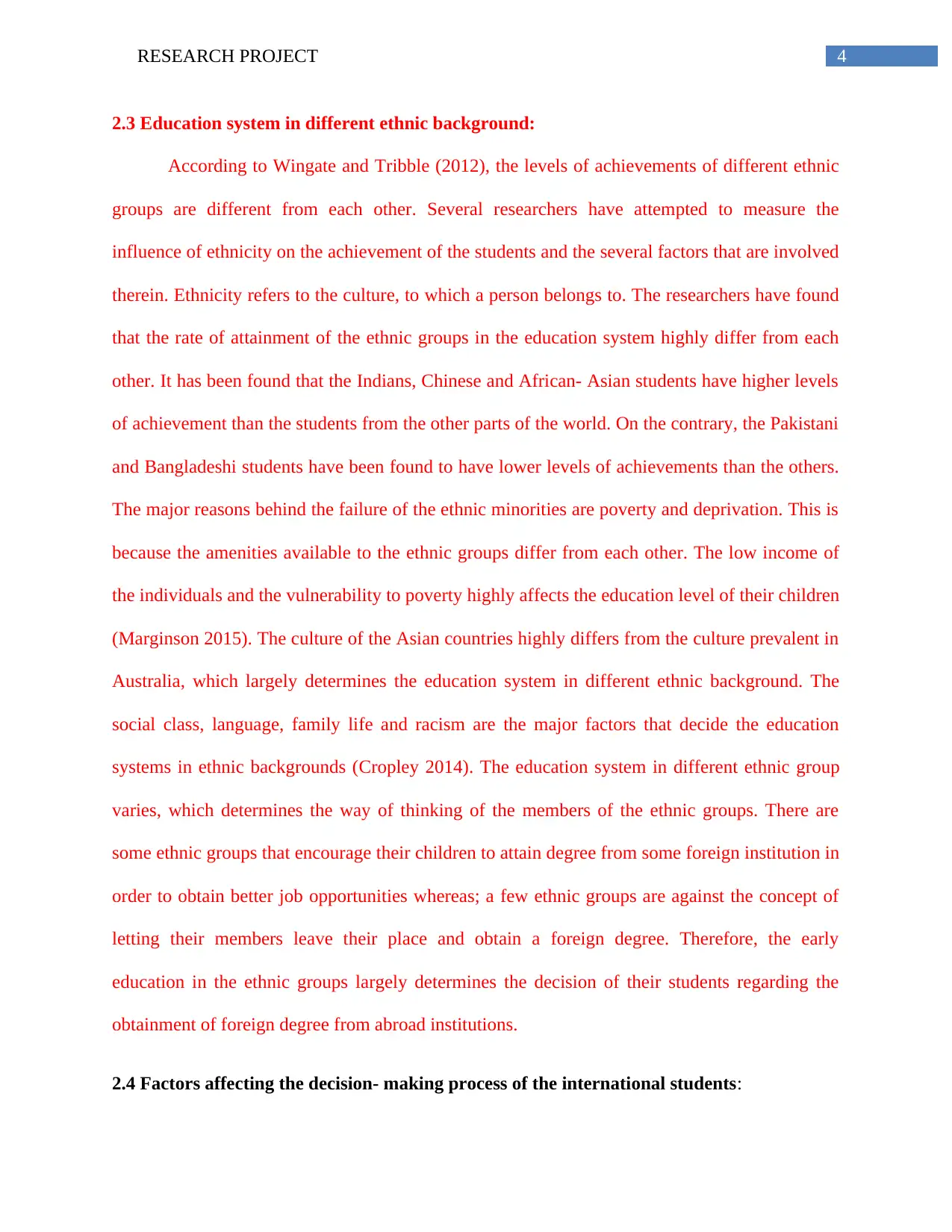
4RESEARCH PROJECT
2.3 Education system in different ethnic background:
According to Wingate and Tribble (2012), the levels of achievements of different ethnic
groups are different from each other. Several researchers have attempted to measure the
influence of ethnicity on the achievement of the students and the several factors that are involved
therein. Ethnicity refers to the culture, to which a person belongs to. The researchers have found
that the rate of attainment of the ethnic groups in the education system highly differ from each
other. It has been found that the Indians, Chinese and African- Asian students have higher levels
of achievement than the students from the other parts of the world. On the contrary, the Pakistani
and Bangladeshi students have been found to have lower levels of achievements than the others.
The major reasons behind the failure of the ethnic minorities are poverty and deprivation. This is
because the amenities available to the ethnic groups differ from each other. The low income of
the individuals and the vulnerability to poverty highly affects the education level of their children
(Marginson 2015). The culture of the Asian countries highly differs from the culture prevalent in
Australia, which largely determines the education system in different ethnic background. The
social class, language, family life and racism are the major factors that decide the education
systems in ethnic backgrounds (Cropley 2014). The education system in different ethnic group
varies, which determines the way of thinking of the members of the ethnic groups. There are
some ethnic groups that encourage their children to attain degree from some foreign institution in
order to obtain better job opportunities whereas; a few ethnic groups are against the concept of
letting their members leave their place and obtain a foreign degree. Therefore, the early
education in the ethnic groups largely determines the decision of their students regarding the
obtainment of foreign degree from abroad institutions.
2.4 Factors affecting the decision- making process of the international students:
2.3 Education system in different ethnic background:
According to Wingate and Tribble (2012), the levels of achievements of different ethnic
groups are different from each other. Several researchers have attempted to measure the
influence of ethnicity on the achievement of the students and the several factors that are involved
therein. Ethnicity refers to the culture, to which a person belongs to. The researchers have found
that the rate of attainment of the ethnic groups in the education system highly differ from each
other. It has been found that the Indians, Chinese and African- Asian students have higher levels
of achievement than the students from the other parts of the world. On the contrary, the Pakistani
and Bangladeshi students have been found to have lower levels of achievements than the others.
The major reasons behind the failure of the ethnic minorities are poverty and deprivation. This is
because the amenities available to the ethnic groups differ from each other. The low income of
the individuals and the vulnerability to poverty highly affects the education level of their children
(Marginson 2015). The culture of the Asian countries highly differs from the culture prevalent in
Australia, which largely determines the education system in different ethnic background. The
social class, language, family life and racism are the major factors that decide the education
systems in ethnic backgrounds (Cropley 2014). The education system in different ethnic group
varies, which determines the way of thinking of the members of the ethnic groups. There are
some ethnic groups that encourage their children to attain degree from some foreign institution in
order to obtain better job opportunities whereas; a few ethnic groups are against the concept of
letting their members leave their place and obtain a foreign degree. Therefore, the early
education in the ethnic groups largely determines the decision of their students regarding the
obtainment of foreign degree from abroad institutions.
2.4 Factors affecting the decision- making process of the international students:
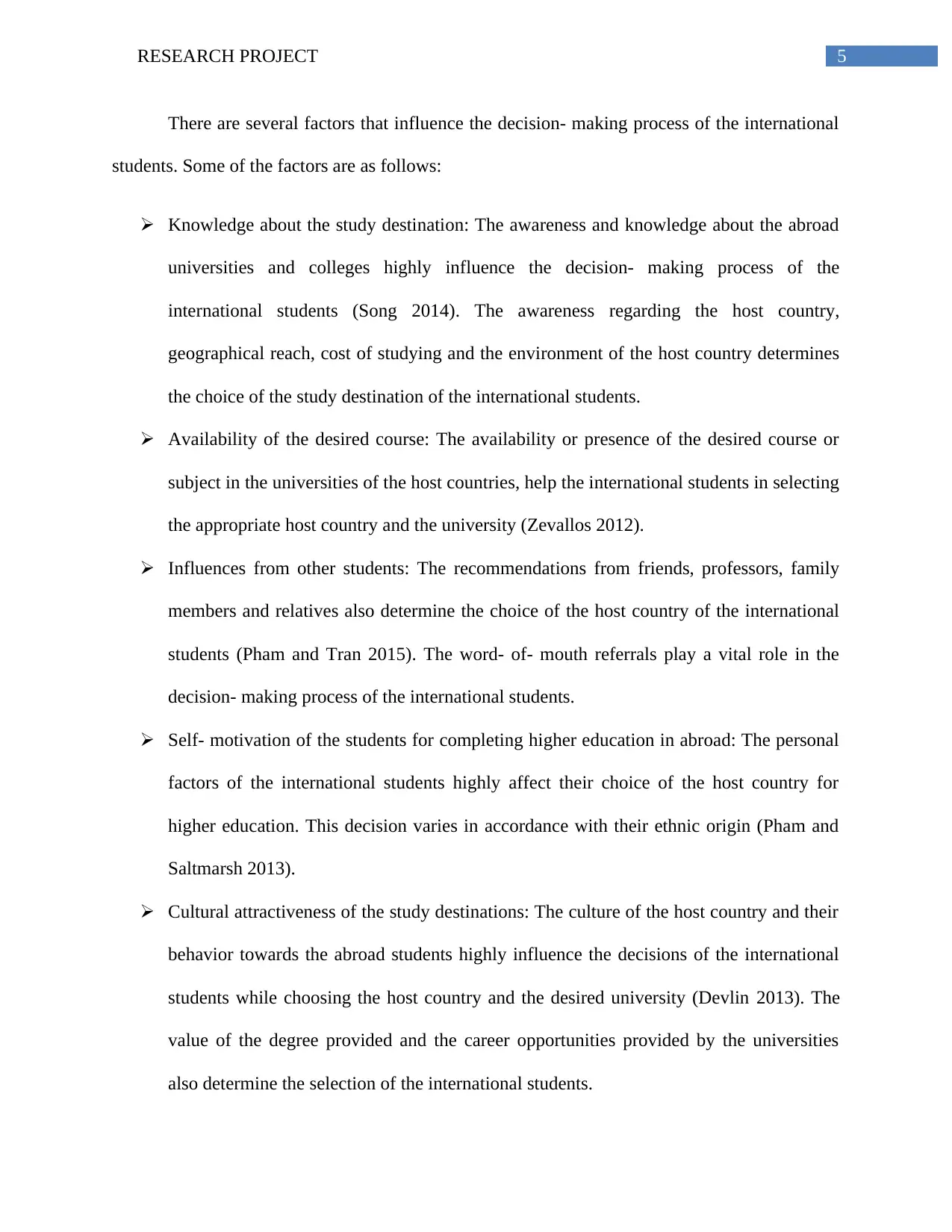
5RESEARCH PROJECT
There are several factors that influence the decision- making process of the international
students. Some of the factors are as follows:
Knowledge about the study destination: The awareness and knowledge about the abroad
universities and colleges highly influence the decision- making process of the
international students (Song 2014). The awareness regarding the host country,
geographical reach, cost of studying and the environment of the host country determines
the choice of the study destination of the international students.
Availability of the desired course: The availability or presence of the desired course or
subject in the universities of the host countries, help the international students in selecting
the appropriate host country and the university (Zevallos 2012).
Influences from other students: The recommendations from friends, professors, family
members and relatives also determine the choice of the host country of the international
students (Pham and Tran 2015). The word- of- mouth referrals play a vital role in the
decision- making process of the international students.
Self- motivation of the students for completing higher education in abroad: The personal
factors of the international students highly affect their choice of the host country for
higher education. This decision varies in accordance with their ethnic origin (Pham and
Saltmarsh 2013).
Cultural attractiveness of the study destinations: The culture of the host country and their
behavior towards the abroad students highly influence the decisions of the international
students while choosing the host country and the desired university (Devlin 2013). The
value of the degree provided and the career opportunities provided by the universities
also determine the selection of the international students.
There are several factors that influence the decision- making process of the international
students. Some of the factors are as follows:
Knowledge about the study destination: The awareness and knowledge about the abroad
universities and colleges highly influence the decision- making process of the
international students (Song 2014). The awareness regarding the host country,
geographical reach, cost of studying and the environment of the host country determines
the choice of the study destination of the international students.
Availability of the desired course: The availability or presence of the desired course or
subject in the universities of the host countries, help the international students in selecting
the appropriate host country and the university (Zevallos 2012).
Influences from other students: The recommendations from friends, professors, family
members and relatives also determine the choice of the host country of the international
students (Pham and Tran 2015). The word- of- mouth referrals play a vital role in the
decision- making process of the international students.
Self- motivation of the students for completing higher education in abroad: The personal
factors of the international students highly affect their choice of the host country for
higher education. This decision varies in accordance with their ethnic origin (Pham and
Saltmarsh 2013).
Cultural attractiveness of the study destinations: The culture of the host country and their
behavior towards the abroad students highly influence the decisions of the international
students while choosing the host country and the desired university (Devlin 2013). The
value of the degree provided and the career opportunities provided by the universities
also determine the selection of the international students.
⊘ This is a preview!⊘
Do you want full access?
Subscribe today to unlock all pages.

Trusted by 1+ million students worldwide
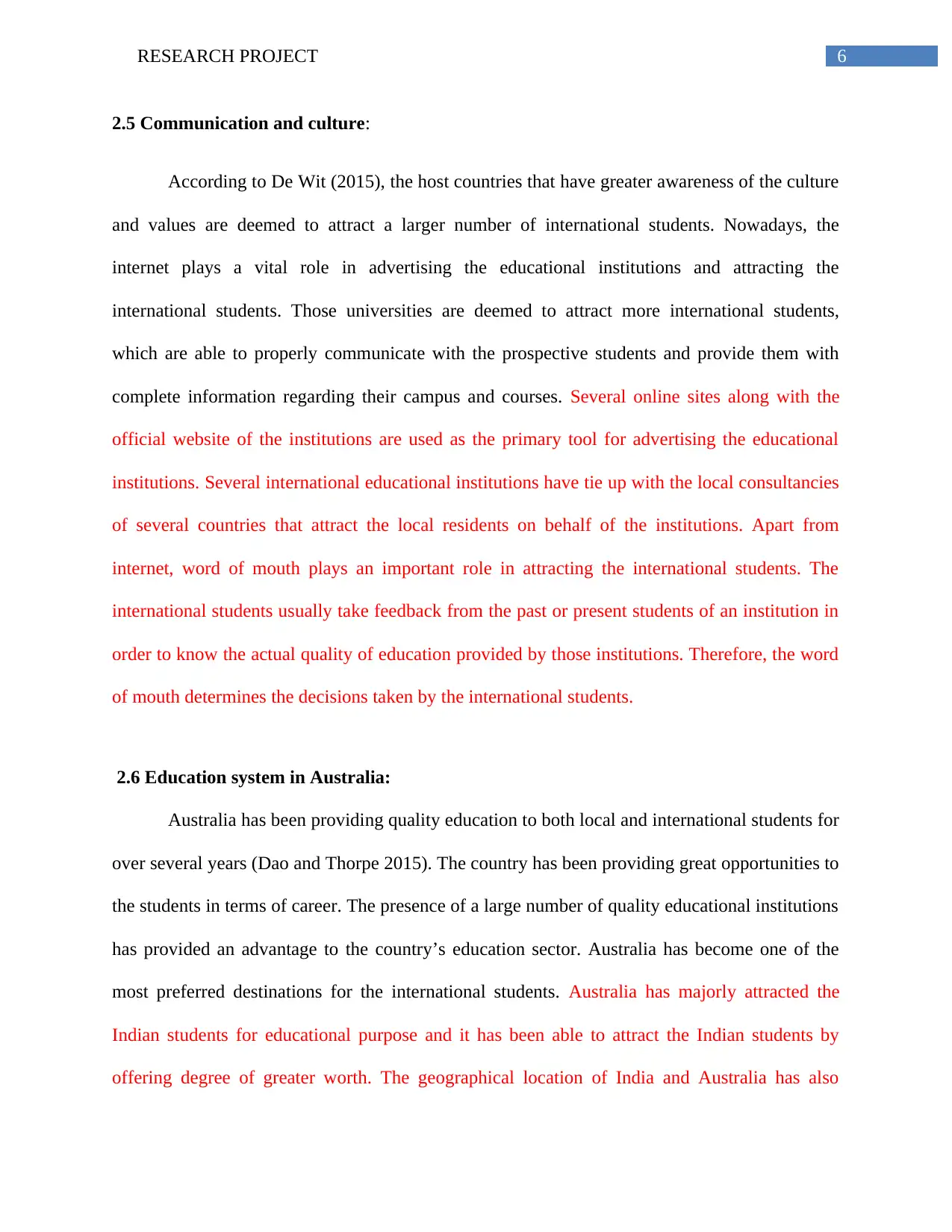
6RESEARCH PROJECT
2.5 Communication and culture:
According to De Wit (2015), the host countries that have greater awareness of the culture
and values are deemed to attract a larger number of international students. Nowadays, the
internet plays a vital role in advertising the educational institutions and attracting the
international students. Those universities are deemed to attract more international students,
which are able to properly communicate with the prospective students and provide them with
complete information regarding their campus and courses. Several online sites along with the
official website of the institutions are used as the primary tool for advertising the educational
institutions. Several international educational institutions have tie up with the local consultancies
of several countries that attract the local residents on behalf of the institutions. Apart from
internet, word of mouth plays an important role in attracting the international students. The
international students usually take feedback from the past or present students of an institution in
order to know the actual quality of education provided by those institutions. Therefore, the word
of mouth determines the decisions taken by the international students.
2.6 Education system in Australia:
Australia has been providing quality education to both local and international students for
over several years (Dao and Thorpe 2015). The country has been providing great opportunities to
the students in terms of career. The presence of a large number of quality educational institutions
has provided an advantage to the country’s education sector. Australia has become one of the
most preferred destinations for the international students. Australia has majorly attracted the
Indian students for educational purpose and it has been able to attract the Indian students by
offering degree of greater worth. The geographical location of India and Australia has also
2.5 Communication and culture:
According to De Wit (2015), the host countries that have greater awareness of the culture
and values are deemed to attract a larger number of international students. Nowadays, the
internet plays a vital role in advertising the educational institutions and attracting the
international students. Those universities are deemed to attract more international students,
which are able to properly communicate with the prospective students and provide them with
complete information regarding their campus and courses. Several online sites along with the
official website of the institutions are used as the primary tool for advertising the educational
institutions. Several international educational institutions have tie up with the local consultancies
of several countries that attract the local residents on behalf of the institutions. Apart from
internet, word of mouth plays an important role in attracting the international students. The
international students usually take feedback from the past or present students of an institution in
order to know the actual quality of education provided by those institutions. Therefore, the word
of mouth determines the decisions taken by the international students.
2.6 Education system in Australia:
Australia has been providing quality education to both local and international students for
over several years (Dao and Thorpe 2015). The country has been providing great opportunities to
the students in terms of career. The presence of a large number of quality educational institutions
has provided an advantage to the country’s education sector. Australia has become one of the
most preferred destinations for the international students. Australia has majorly attracted the
Indian students for educational purpose and it has been able to attract the Indian students by
offering degree of greater worth. The geographical location of India and Australia has also
Paraphrase This Document
Need a fresh take? Get an instant paraphrase of this document with our AI Paraphraser
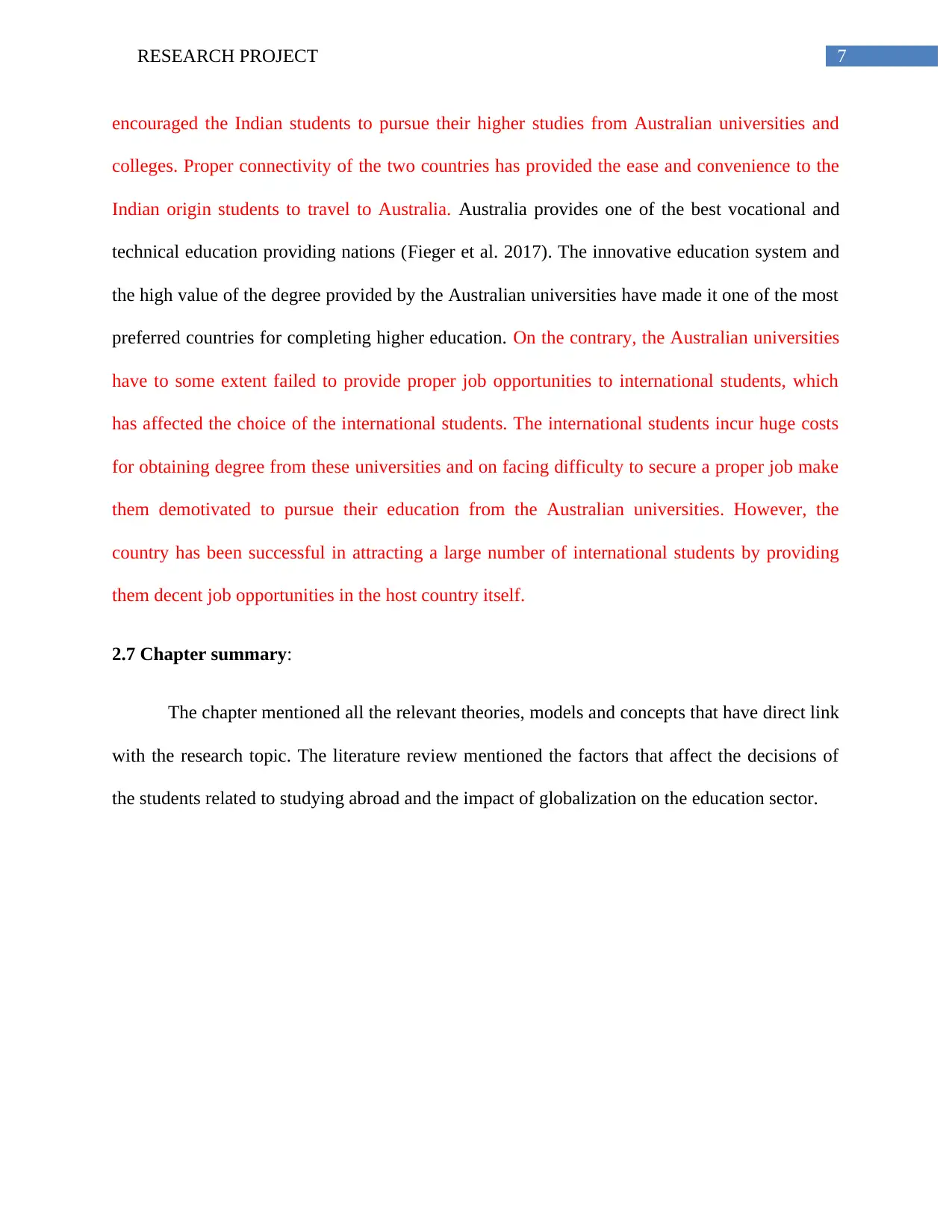
7RESEARCH PROJECT
encouraged the Indian students to pursue their higher studies from Australian universities and
colleges. Proper connectivity of the two countries has provided the ease and convenience to the
Indian origin students to travel to Australia. Australia provides one of the best vocational and
technical education providing nations (Fieger et al. 2017). The innovative education system and
the high value of the degree provided by the Australian universities have made it one of the most
preferred countries for completing higher education. On the contrary, the Australian universities
have to some extent failed to provide proper job opportunities to international students, which
has affected the choice of the international students. The international students incur huge costs
for obtaining degree from these universities and on facing difficulty to secure a proper job make
them demotivated to pursue their education from the Australian universities. However, the
country has been successful in attracting a large number of international students by providing
them decent job opportunities in the host country itself.
2.7 Chapter summary:
The chapter mentioned all the relevant theories, models and concepts that have direct link
with the research topic. The literature review mentioned the factors that affect the decisions of
the students related to studying abroad and the impact of globalization on the education sector.
encouraged the Indian students to pursue their higher studies from Australian universities and
colleges. Proper connectivity of the two countries has provided the ease and convenience to the
Indian origin students to travel to Australia. Australia provides one of the best vocational and
technical education providing nations (Fieger et al. 2017). The innovative education system and
the high value of the degree provided by the Australian universities have made it one of the most
preferred countries for completing higher education. On the contrary, the Australian universities
have to some extent failed to provide proper job opportunities to international students, which
has affected the choice of the international students. The international students incur huge costs
for obtaining degree from these universities and on facing difficulty to secure a proper job make
them demotivated to pursue their education from the Australian universities. However, the
country has been successful in attracting a large number of international students by providing
them decent job opportunities in the host country itself.
2.7 Chapter summary:
The chapter mentioned all the relevant theories, models and concepts that have direct link
with the research topic. The literature review mentioned the factors that affect the decisions of
the students related to studying abroad and the impact of globalization on the education sector.
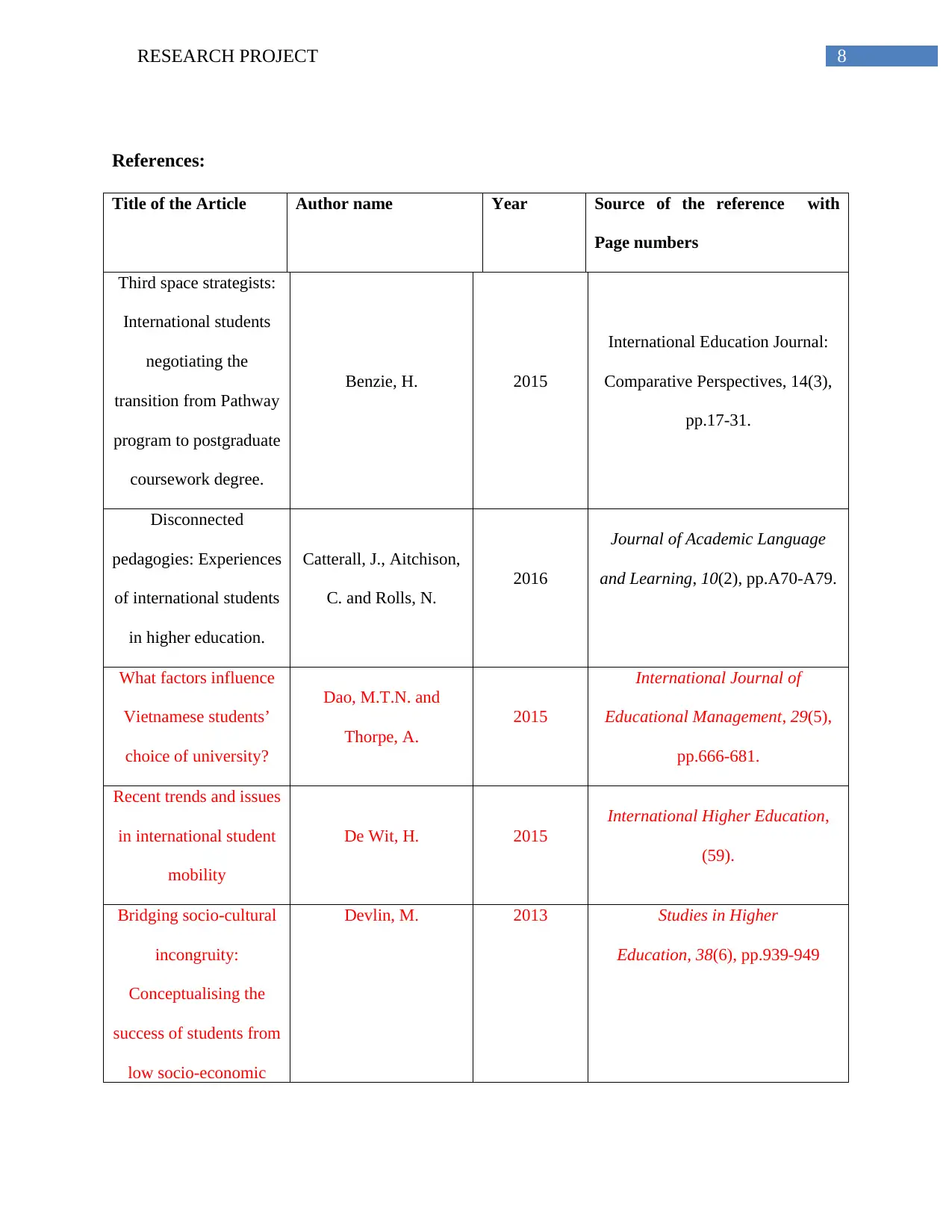
8RESEARCH PROJECT
References:
Title of the Article Author name Year Source of the reference with
Page numbers
Third space strategists:
International students
negotiating the
transition from Pathway
program to postgraduate
coursework degree.
Benzie, H. 2015
International Education Journal:
Comparative Perspectives, 14(3),
pp.17-31.
Disconnected
pedagogies: Experiences
of international students
in higher education.
Catterall, J., Aitchison,
C. and Rolls, N.
2016
Journal of Academic Language
and Learning, 10(2), pp.A70-A79.
What factors influence
Vietnamese students’
choice of university?
Dao, M.T.N. and
Thorpe, A.
2015
International Journal of
Educational Management, 29(5),
pp.666-681.
Recent trends and issues
in international student
mobility
De Wit, H. 2015
International Higher Education,
(59).
Bridging socio-cultural
incongruity:
Conceptualising the
success of students from
low socio-economic
Devlin, M. 2013 Studies in Higher
Education, 38(6), pp.939-949
References:
Title of the Article Author name Year Source of the reference with
Page numbers
Third space strategists:
International students
negotiating the
transition from Pathway
program to postgraduate
coursework degree.
Benzie, H. 2015
International Education Journal:
Comparative Perspectives, 14(3),
pp.17-31.
Disconnected
pedagogies: Experiences
of international students
in higher education.
Catterall, J., Aitchison,
C. and Rolls, N.
2016
Journal of Academic Language
and Learning, 10(2), pp.A70-A79.
What factors influence
Vietnamese students’
choice of university?
Dao, M.T.N. and
Thorpe, A.
2015
International Journal of
Educational Management, 29(5),
pp.666-681.
Recent trends and issues
in international student
mobility
De Wit, H. 2015
International Higher Education,
(59).
Bridging socio-cultural
incongruity:
Conceptualising the
success of students from
low socio-economic
Devlin, M. 2013 Studies in Higher
Education, 38(6), pp.939-949
⊘ This is a preview!⊘
Do you want full access?
Subscribe today to unlock all pages.

Trusted by 1+ million students worldwide
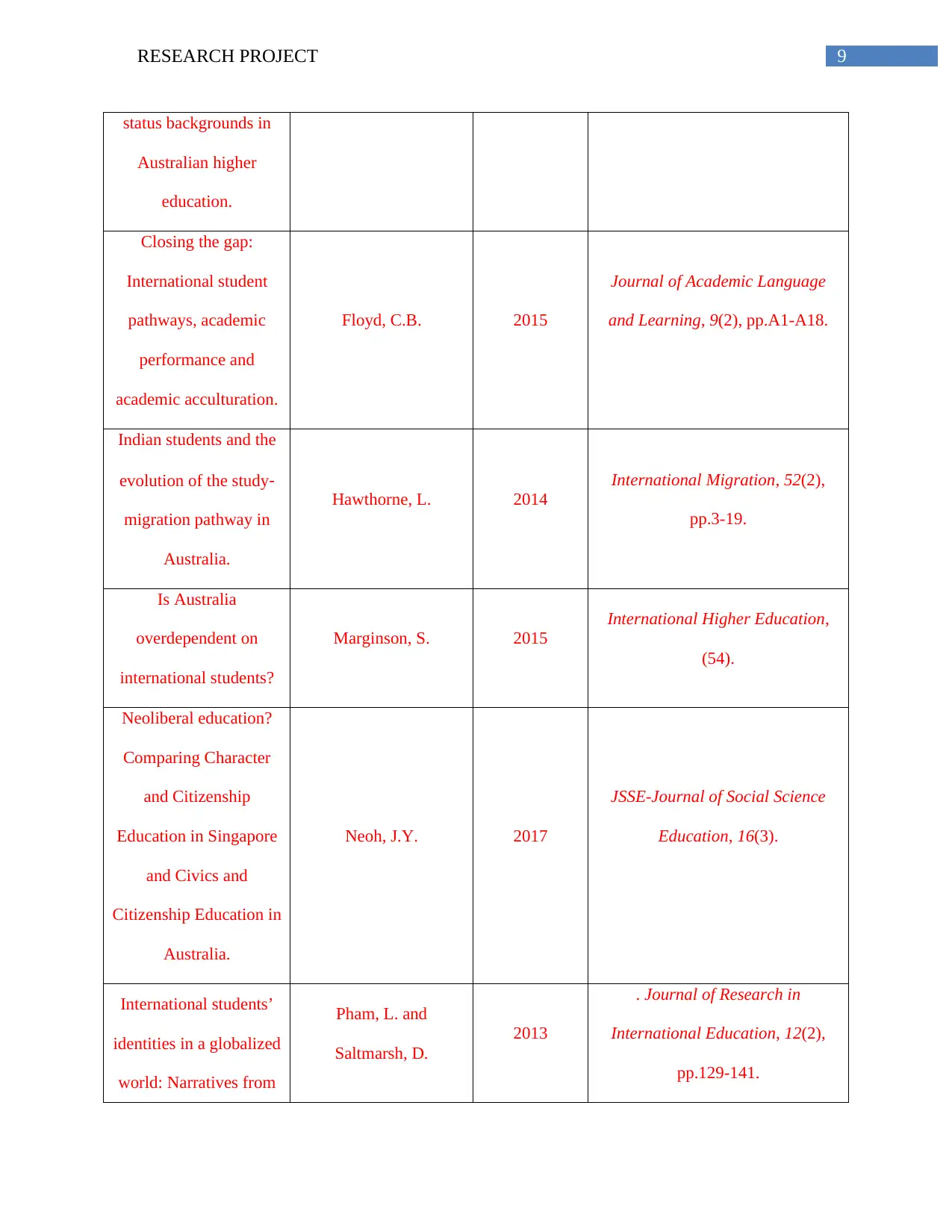
9RESEARCH PROJECT
status backgrounds in
Australian higher
education.
Closing the gap:
International student
pathways, academic
performance and
academic acculturation.
Floyd, C.B. 2015
Journal of Academic Language
and Learning, 9(2), pp.A1-A18.
Indian students and the
evolution of the study‐
migration pathway in
Australia.
Hawthorne, L. 2014
International Migration, 52(2),
pp.3-19.
Is Australia
overdependent on
international students?
Marginson, S. 2015
International Higher Education,
(54).
Neoliberal education?
Comparing Character
and Citizenship
Education in Singapore
and Civics and
Citizenship Education in
Australia.
Neoh, J.Y. 2017
JSSE-Journal of Social Science
Education, 16(3).
International students’
identities in a globalized
world: Narratives from
Pham, L. and
Saltmarsh, D.
2013
. Journal of Research in
International Education, 12(2),
pp.129-141.
status backgrounds in
Australian higher
education.
Closing the gap:
International student
pathways, academic
performance and
academic acculturation.
Floyd, C.B. 2015
Journal of Academic Language
and Learning, 9(2), pp.A1-A18.
Indian students and the
evolution of the study‐
migration pathway in
Australia.
Hawthorne, L. 2014
International Migration, 52(2),
pp.3-19.
Is Australia
overdependent on
international students?
Marginson, S. 2015
International Higher Education,
(54).
Neoliberal education?
Comparing Character
and Citizenship
Education in Singapore
and Civics and
Citizenship Education in
Australia.
Neoh, J.Y. 2017
JSSE-Journal of Social Science
Education, 16(3).
International students’
identities in a globalized
world: Narratives from
Pham, L. and
Saltmarsh, D.
2013
. Journal of Research in
International Education, 12(2),
pp.129-141.
Paraphrase This Document
Need a fresh take? Get an instant paraphrase of this document with our AI Paraphraser
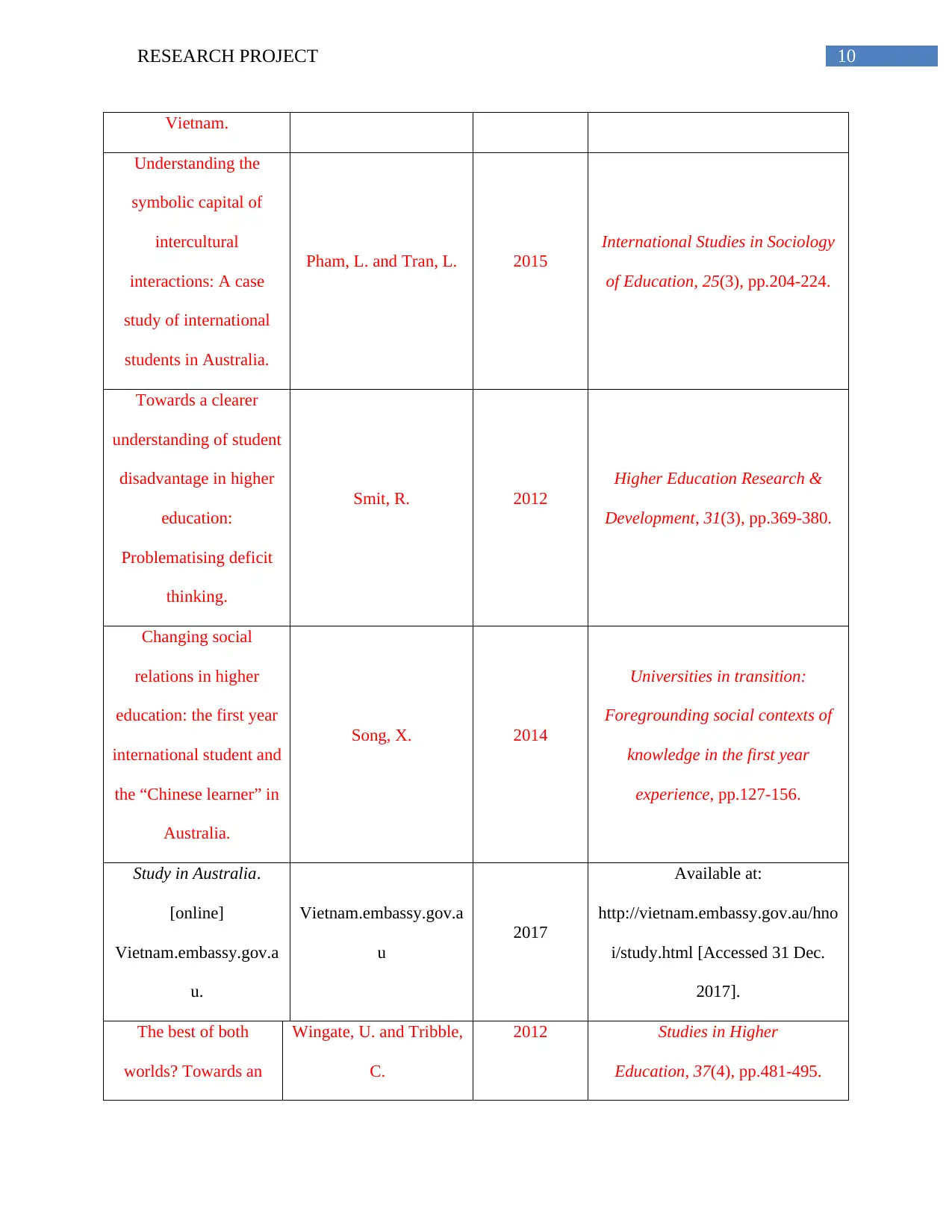
10RESEARCH PROJECT
Vietnam.
Understanding the
symbolic capital of
intercultural
interactions: A case
study of international
students in Australia.
Pham, L. and Tran, L. 2015
International Studies in Sociology
of Education, 25(3), pp.204-224.
Towards a clearer
understanding of student
disadvantage in higher
education:
Problematising deficit
thinking.
Smit, R. 2012
Higher Education Research &
Development, 31(3), pp.369-380.
Changing social
relations in higher
education: the first year
international student and
the “Chinese learner” in
Australia.
Song, X. 2014
Universities in transition:
Foregrounding social contexts of
knowledge in the first year
experience, pp.127-156.
Study in Australia.
[online]
Vietnam.embassy.gov.a
u.
Vietnam.embassy.gov.a
u
2017
Available at:
http://vietnam.embassy.gov.au/hno
i/study.html [Accessed 31 Dec.
2017].
The best of both
worlds? Towards an
Wingate, U. and Tribble,
C.
2012 Studies in Higher
Education, 37(4), pp.481-495.
Vietnam.
Understanding the
symbolic capital of
intercultural
interactions: A case
study of international
students in Australia.
Pham, L. and Tran, L. 2015
International Studies in Sociology
of Education, 25(3), pp.204-224.
Towards a clearer
understanding of student
disadvantage in higher
education:
Problematising deficit
thinking.
Smit, R. 2012
Higher Education Research &
Development, 31(3), pp.369-380.
Changing social
relations in higher
education: the first year
international student and
the “Chinese learner” in
Australia.
Song, X. 2014
Universities in transition:
Foregrounding social contexts of
knowledge in the first year
experience, pp.127-156.
Study in Australia.
[online]
Vietnam.embassy.gov.a
u.
Vietnam.embassy.gov.a
u
2017
Available at:
http://vietnam.embassy.gov.au/hno
i/study.html [Accessed 31 Dec.
2017].
The best of both
worlds? Towards an
Wingate, U. and Tribble,
C.
2012 Studies in Higher
Education, 37(4), pp.481-495.
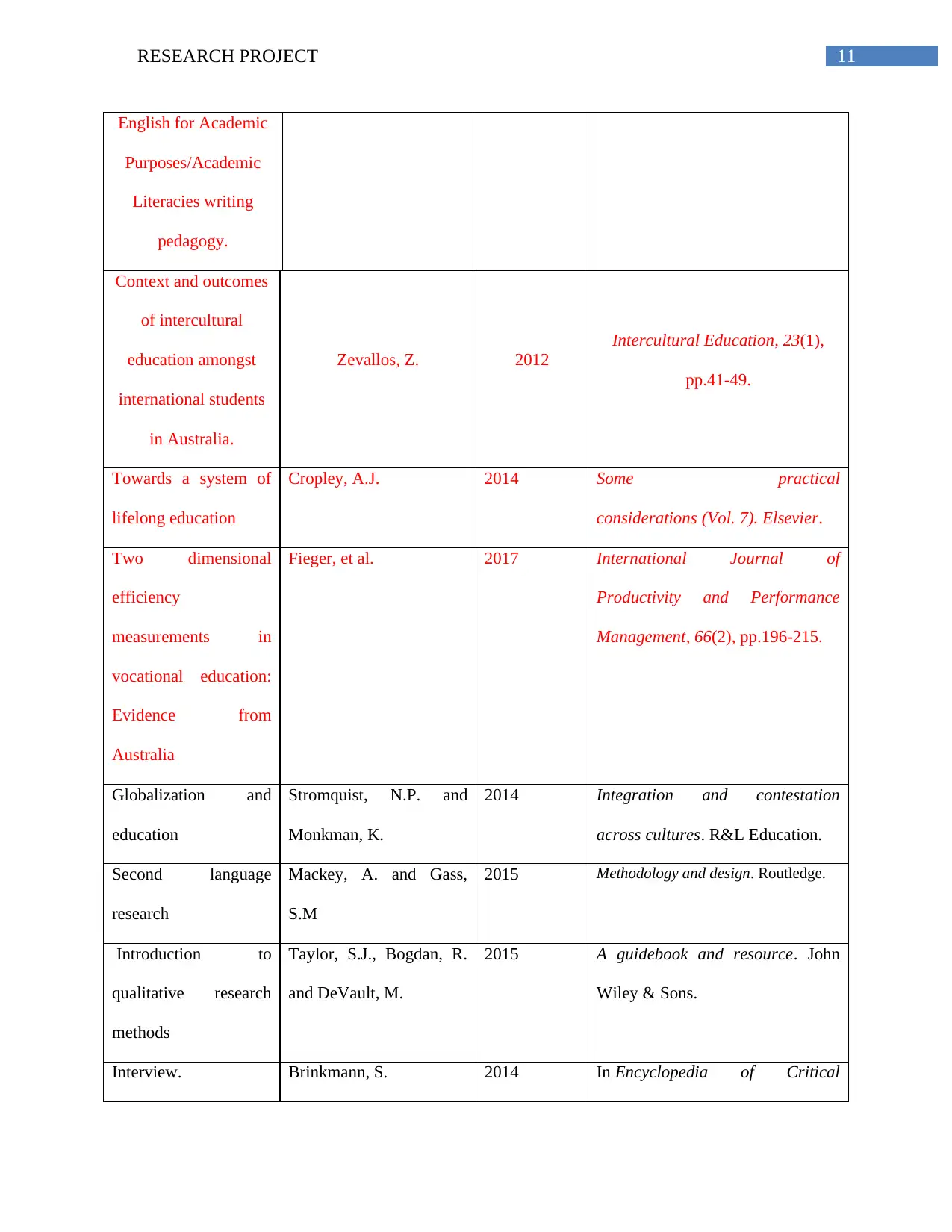
11RESEARCH PROJECT
English for Academic
Purposes/Academic
Literacies writing
pedagogy.
Context and outcomes
of intercultural
education amongst
international students
in Australia.
Zevallos, Z. 2012
Intercultural Education, 23(1),
pp.41-49.
Towards a system of
lifelong education
Cropley, A.J. 2014 Some practical
considerations (Vol. 7). Elsevier.
Two dimensional
efficiency
measurements in
vocational education:
Evidence from
Australia
Fieger, et al. 2017 International Journal of
Productivity and Performance
Management, 66(2), pp.196-215.
Globalization and
education
Stromquist, N.P. and
Monkman, K.
2014 Integration and contestation
across cultures. R&L Education.
Second language
research
Mackey, A. and Gass,
S.M
2015 Methodology and design. Routledge.
Introduction to
qualitative research
methods
Taylor, S.J., Bogdan, R.
and DeVault, M.
2015 A guidebook and resource. John
Wiley & Sons.
Interview. Brinkmann, S. 2014 In Encyclopedia of Critical
English for Academic
Purposes/Academic
Literacies writing
pedagogy.
Context and outcomes
of intercultural
education amongst
international students
in Australia.
Zevallos, Z. 2012
Intercultural Education, 23(1),
pp.41-49.
Towards a system of
lifelong education
Cropley, A.J. 2014 Some practical
considerations (Vol. 7). Elsevier.
Two dimensional
efficiency
measurements in
vocational education:
Evidence from
Australia
Fieger, et al. 2017 International Journal of
Productivity and Performance
Management, 66(2), pp.196-215.
Globalization and
education
Stromquist, N.P. and
Monkman, K.
2014 Integration and contestation
across cultures. R&L Education.
Second language
research
Mackey, A. and Gass,
S.M
2015 Methodology and design. Routledge.
Introduction to
qualitative research
methods
Taylor, S.J., Bogdan, R.
and DeVault, M.
2015 A guidebook and resource. John
Wiley & Sons.
Interview. Brinkmann, S. 2014 In Encyclopedia of Critical
⊘ This is a preview!⊘
Do you want full access?
Subscribe today to unlock all pages.

Trusted by 1+ million students worldwide
1 out of 12
Related Documents
Your All-in-One AI-Powered Toolkit for Academic Success.
+13062052269
info@desklib.com
Available 24*7 on WhatsApp / Email
![[object Object]](/_next/static/media/star-bottom.7253800d.svg)
Unlock your academic potential
Copyright © 2020–2025 A2Z Services. All Rights Reserved. Developed and managed by ZUCOL.





